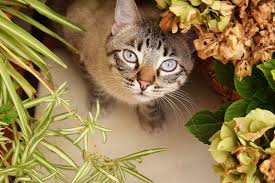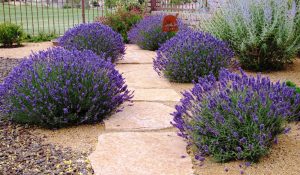by Ken Lain, the mountain gardener

Cats in the garden seem to be an issue this week while helping customers at the garden center this week, so let’s cover the subject in detail. I am often asked how to keep cats out of the yard. Cats are unpredictable, so there are few sure-fire cat repellents. But below I consider some of the best approaches known to stop strays and other feline intruders from using your garden as their own personal litter box.
Broadly speaking, we can label all of these diverse approaches as “cat repellents,” since they are all designed to repel unwanted cats from a specific area.
But I will also provide an example of the commercial products more narrowly associated with the label, “cat repellents,” namely, products that come in a can and are sprinkled on the ground to keep cats away.
A Cat Repellent for Before You Even Begin
If you have not planted a flower bed yet, but you anticipate having trouble keeping cats out of your yard, be aware that one of the most effective cat repellents is readily available at most any hardware store: chicken wire.
No, I am not going to suggest you erect a chicken-wire fence. Instead, lay chicken wire down on top of your soil (or mulch, if you are using mulch in the bed), across the planting bed, before you plant. Why? Because cats disdain walking on chicken wire. Using wire cutters, you will be able to open up pockets in the chicken wire sufficiently large for installing your plants.
After-the-Fact Methods: 10 Ways to Keep Cats Out of Your Yard
But what if it is too late for the chicken-wire option? Not to worry. The 10 cat repellents on which I focus below are all intended for existing garden beds. While on the subject of wire, I will begin with electric wire fences.
- Like rabbits, cats can be kept away humanely with the popular Mr. McGregor Fence, a fence so safe that even ResponsibleConsumer.Net recommends it.
Water: The Ultimate Cat Repellent?
Sometimes, to keep cats away from a yard, you have to think like a cat. Put yourself in the cat’s place. Observe cat behavior. For instance, they’re pretty fussy creatures, aren’t they?
One of the things cats are fussy about is getting wet. Water is “Kryptonite for cats.” Getting wet seems to be almost a phobia for them.
Use that phobia to your advantage in trying to keep cats away from yards.
- When you catch cats in the forbidden area, you can try hosing them down with a Super Soaker or similar water gun. Such action may reinforce the notion that they are unwanted in your planting bed.
- But if that doesn’t work, you can go hi-tech. Devices such as Scarecrow Sprinklersdetect an intruder’s presence and fire a blast of water at it.
Thinking like a cat again, another thing we can say cats are fussy about is how something smells. You can use feline fastidiousness to keep cats away from your yard in a number of ways:
Commercial Cat Repellents
- One of the commercial cat repellents available is a powder called, “Shake-Away.” Shake-Away bears the scent of the urine of predators that cats fear, namely, the coyote, the fox and the bobcat. This commercial cat repellent comes in a granular form, which you simply sprinkle around the problem area. The product is advertised as being organic, making it an acceptable option to use around children and pets. Nor will it harm your plants.
Plants That Keep Cats Away From Your Yard
- Some plants give off smells that cats dislike. One such plant, Coleus canina, goes by the common name, “scaredy cat plant.” As the second term in the Latin name indicates (think “canine”), it is also effective if you have trouble landscaping with dogs. I offer a separate article on dog repellents. Other plants often
 recommended for keeping cats away from yards are:
recommended for keeping cats away from yards are:
- rue,
- lavender, which is also a deer-resistant plant
- pennyroyal
Other Substances That Double as Cat Repellents
- Try sprinkling “stinky” substances around the problem area, including:
- dried-blood (“blood meal“) fertilizer
- mothballs (drop them into a can or jar, cover, and make a few holes in the cover)
- cayenne pepper flakes (but see below)
Note that mothballs are toxic, thus the recommendation that you use them in a covered can or jar. Avoid even this usage if small children will be in the yard and could, potentially, open such a can or jar. Note also that some people caution against using cayenne pepper in this fashion, saying it can be harmful to cats. So if you’re an animal lover or tend to be on the cautious side, then save the cayenne pepper to flavor your food!
Still “thinking like a cat,” let’s consider something else felines are fussy about: the texture of what they step on. This is one natural way to keep cats out of the yard — more specifically, to keep cats from pooping in your garden. After all, it is not for nothing we have the expression, “pussyfooting around.” I already mentioned chicken wire in this context on Page 1, but below I will suggest a couple of materials found in nature.
Natural Cat Repellents Underfoot: No “Pussyfooting Around”
- Cats do not like to walk on bristly material. So here is an idea: in mulching the problem bed, include something on which the refined paws of cats will fear to tread, such as sharp-edged pine cones.
- Another mulch that functions as a natural cat repellent is stone mulch.
It may not be the most attractive type of mulch for your particular bed, but cats prefer to poop in loose dirt. Cats usually will not bother with an area mulched in stone. They would rather be “pussyfooting around” where the digging’s easier on their paws.
Striking a Compromise: Grow Catnip, Make a Sandbox
In addition to the natural cat repellents suggested above, I had alluded to others on Page 1, including water, strong-smelling plants, and stinky substances such as dried-blood. But I am going to change course for a moment and deal with some other methods for keeping cats from pooping in gardens — methods that involve compromising rather than repelling.
As in landscaping with dogs, sometimes the path of least resistance provides the best solution to your problem.
Strike a compromise with your cat by planting a separate bed of catnip plants, in another part of the yard. Not all cats go nuts over catnip plants, but those who do may come to view their “catnip patch” as their own private sanctuary and make it their new favorite hangout, thereby allowing you to keep your garden as your own sanctuary.
- Better still, make a sandbox just for cats and keep it in close proximity to the catnip plants. Chances are that the sandbox will serve as a magnet for cat poop. Sure, you will have to clean up the cat poop afterwards. But at least you will know where it is.
How to Keep Cats From Pooping in Your Garden: Hi-Tech to the Rescue, Again
Hi-tech approaches to keeping cats from pooping in gardens do not stop with the motion-activated sprinklers.
You can also use ultrasound.
- Ultrasound devices such as Cat Stop operate on a high frequency. It is inaudible to humans but unbearable for cats. Installation is easy. You simply situate the device so that it faces toward the garden. A motion sensor detects the intruder’s presence, and Cat Stop then gives off its high-frequency sound, scaring off the cat.
Addendum 1: Why You Should Learn How to Repel Cats
The concern over how to repel cats is readily understandable and has nothing to do with whether or not one likes cats. Nor does it matter that much whether the cats in question are your own or someone else’s. After all, it stinks to be working away cheerfully in the garden, only to end up stepping in cat poop! But the need for cat repellents goes beyond mere inconvenience. Cat poop can harbor pathogens harmful to humans. Ultimately, this is an issue of proper sanitation in the yard.
“But,” you may protest, “the manure of barnyard animals is often used by gardeners. How is cat poop different?” Well, cat poop differs in one very important respect from, say, cow manure: the former is the product of a carnivore, not an herbivore. If your neighbor’s cat is using your garden as a toilet, how do you know the cat’s poop doesn’t contain parasites passed on by its prey?
Addendum 2: What If I Compost Cat Poop First?
Nor is composting cat poop recommended, unless you are an expert in the science of how to make compost. Theoretically, you could heat the pile up enough to kill any pathogens in the cat poop. But you would need to be very meticulous about it. For most people, composting cat poop would not be worth the risk.
But Don’t Stop Here!
Did you find this information helpful? If so, you may want to make use of the many articles I have on this website that deal with other topics. I cover just about everything you can think of that pertains to making your yard a more enjoyable space. An easy way to begin accessing these resources is to sign up for my weekly Landscaping Newsletter.
Tremendous new resource for new gardeners https://groomandstyle.com/gardening-beginners-first-garden/


Some of these oils like citronella oil, work not just for cats , but keep also wasps out of your yard . Cats , especially strays and unwanted cats , can be quite a nuisance when it comes to pooping in your yard …